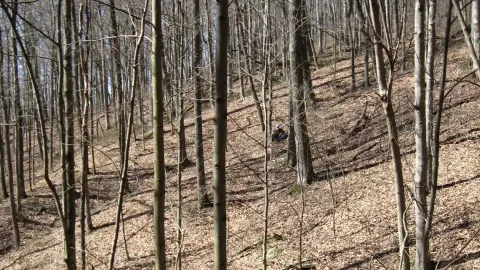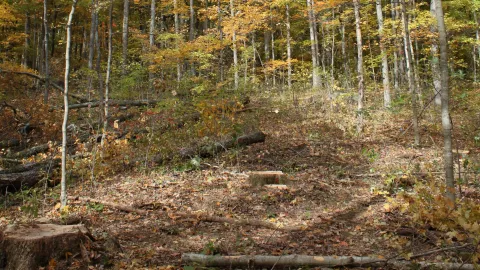Silviculture and Forest Management
Silviculture and Forest Management
Informing Oak Silvicultural Practice through Study of Growth and Regeneration
A McIntire-Stennis supported project
Oaks are responsible for generating billions of dollars to the economy of Kentucky and surrounding states. Oak is used in a wide range of products, from paper and pallets to bourbon barrels, the latter produced from white oak, a dominant species in the central hardwood region and a focus species of research at the University of Kentucky Department of Forestry and Natural Resources. Unfortunately, inadequacy in the natural regeneration of several oak species, including white oak, are predicted to result in long-term issues with the sustainability of oak forests, the availability of oak timber, and a reduction in a valuable food for wildlife.
McIntire-Stennis supported research aims to develop management (silvicultural) practices to directly enhance the sustainability of oak forests. Our work focuses on foundational stand yield relationships and the development of thinning and regeneration practices. Our science can be applied at key phases of an oak forest’s lifecycle to have an immediate impact on stabilizing the growth and drain of our oak resources.
Collaboration
The work is endorsed by the White Oak Initiative and completed in partnership with the USDA Forest Service Southern Research Station, USDA Forest Service Northern Research Station, USDA Forest Service Daniel Boone National Forest, Forest Health Research and Education Center, Berea College, and the University of Vermont.
Impact
Science has resulted in the development of advanced techniques to culture oaks and is building our foundational understanding of oak regeneration, growth, and development.
Advanced Practices
developed including gap-based systems and how to apply shelterwood techniques to enhance oak regeneration.
Leading
long-term evaluation of individual tree and stand response to thinning within the Central Hardwood Region.
1,200 acres
annually being managed using scientifically based practices developed or investigated by this project.
Additional Research

Effect of grading technique on forest productivity of high-value tree species in reforested surface mine lands
In 1997, the University of Kentucky began research on the Starfire Mine in Perry County, Kentucky in order to test the effects of surface grading technique and organic soil amendment on both soil formation and the survival and growth of trees on surface mine sites. Three cells each of highly compacted, minimally compacted and non-compacted material were planted with seven tree species and subjected to various soil amendment treatments. In the current study, investigators will carry out an inventory of the stands, which have now reached canopy closure. The investigators will also measure chemical and physical properties of soil in the research cells in order to evaluate the effects of the various treatments on soil formation, which is important for the productivity of such sites. Data collected during this study will allow the investigators to evaluate the growth of trees on surface mines under the various treatments and will therefore assist in the development of reforestation methods capable of returning high-value tree species to mined lands.

Modeling long-term stand density, growth, and recruitment relationships in upland oak stands of central hardwood forest region
This study utilizes four USDA Forest Service thinning experiments established more than 50 years ago in Kentucky and Ohio. Experimental locations provide a unique opportunity to quantify the growth, recruitment, and survival of oak and associated species across a range of stand density conditions. The dataset represents one of the most long-term for thinned oak stands within the region. An understanding of tree and stand relationships is gained through the development of diameter growth and survival models along with a simulation framework for evaluating basal area and volume growth following an array of thinning practices. Scientific outputs will have implications in silvicultural and economic decision making regarding the use of thinning to meet diverse landowner objectives.

Formulating an expanding-gap regeneration system for oak dominated stands
Although Femelschlag systems are used throughout Europe, few documented examples of these expanding-gap shelterwood practices exist in North American oak forests. In 2012, a replicated study incorporating twelve silvicultural gaps was established among three locations on Berea College Forest. The study tests two initial treatments to be used in the development of an expanding-gap silvicultural system for oak-dominated forests. The study documents whether spatial light and tree regeneration patterns associated with the treatments are beneficial to oak. The study will provide the first long-term look at this practice as a means for addressing the region’s oak regeneration issues and will serve as a platform for other investigations that address interdisciplinary questions.
Associated Faculty
Research Topic Areas
Research Quick Links
Forestry and Natural Resources Department
forestry.department@uky.edu
(859) 257-7596
Forestry and Natural Resources Extension
forestry.extension@uky.edu
(859) 257-7597
